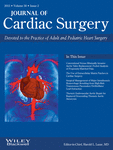Conventional Versus Minimally Invasive Aortic Valve Replacement: Pooled Analysis of Propensity-Matched Data
ABSTRACT
Background
Minimally invasive aortic valve replacement (mAVR) is increasingly preferred over conventional AVR (cAVR). However, data comparing these procedures present conflicting results. Hence, we conducted a systematic review and meta-analysis comparing clinical results in these cohorts.
Method
Only randomized controlled trials (RCT) and propensity-matched observational studies (POS) (1998–2013) comparing clinical outcome of patients subjected to mAVR or cAVR were pooled. Continuous data was compared using mean/standardized mean difference (MD/SMD) while categorical results were pooled to obtain an odds ratio (OR) with a 95% confidence interval.
Results
A total of 18 studies (6 RCT and 12 POS) (1973 mAVR patients; 2697 cAVR patients) were analyzed. The mean ischemic time was significantly longer with mAVR (MD 9.42 minutes [4.25–14.59]; p < 0.01). However, early mortality (mAVR [1.8%] and cAVR [3%]) was comparable (OR 0.70 [0.46–1.06]; p = 0.09). Postoperative ventilation time was slightly shorter after mAVR (7.5 vs 11.1 hours; p = 0.07), and hospital discharge was earlier after mAVR (MD −1.05 [−1.64 to −0.46]; p < 0.01). However, mAVR failed to reduce transfusion requirement (OR 0.77 [0.51–1.14]; p = 0.19) or pain scores (SMD −0.25 [−0.65 to 0.13]; p = 0.20). Postoperative atrial fibrillation (p = 0.67) and stroke (p = 0.79) rates were comparable. Pooled rate of conversion to full sternotomy was 2.5%. Cosmetic satisfaction could not be pooled due to reporting heterogeneity.
Conclusion
Minimally invasive aortic valve replacement can be performed safely despite the longer ischemic time. While minimally invasive surgery does demonstrate some advantages in postoperative recovery, we failed to find any other substantial improvement in outcome over conventional aortic valve replacement. doi: 10.1111/jocs.12493 (J Card Surg 2015;30:125–134)




